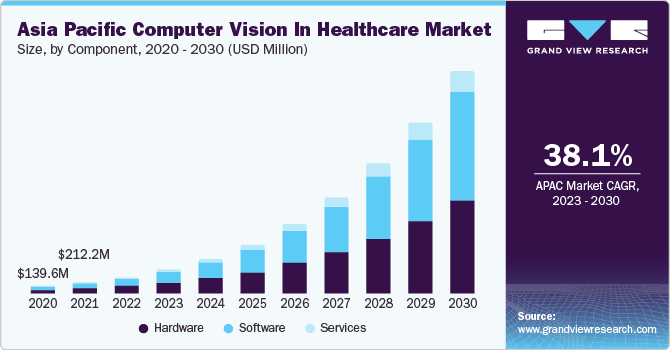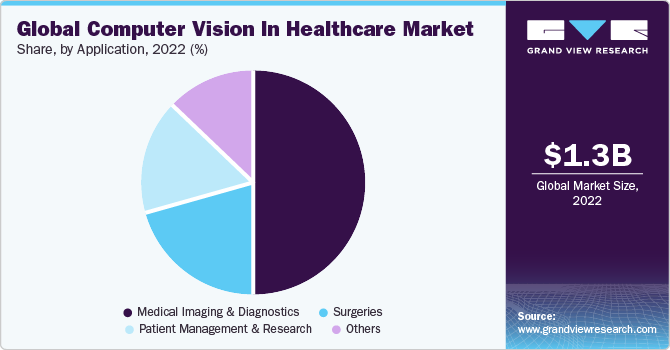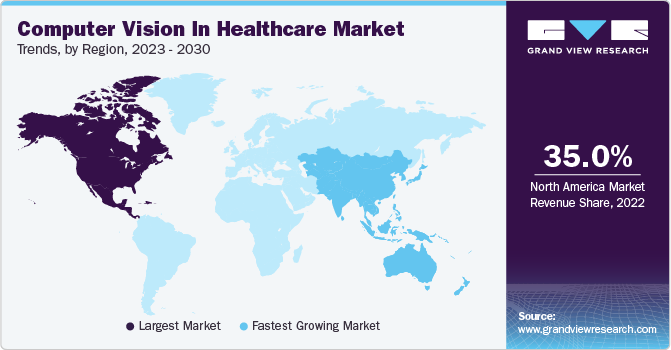- Home
- »
- Next Generation Technologies
- »
-
Computer Vision In Healthcare Market Size Report, 2030GVR Report cover
![Computer Vision In Healthcare Market Size, Share & Trends Report]()
Computer Vision In Healthcare Market Size, Share & Trends Analysis Report By Component (Hardware, Software), By Product Type (Smart Cameras-based, PC-based), By End-user, By Application, By Region, And Segment Forecasts, 2023 - 2030
- Report ID: GVR-4-68040-134-5
- Number of Report Pages: 100
- Format: PDF, Horizon Databook
- Historical Range: 2017 - 2021
- Forecast Period: 2023 - 2030
- Industry: Technology
Market Size & Trends
The global computer vision in healthcare market size was estimated at USD 1.31 billion in 2022 and is expected to grow at a compound annual growth rate (CAGR) of 35.2% from 2023 to 2030. This substantial growth is attributed to several factors, including the rising need for computer vision systems in the healthcare sector, government efforts to boost the adoption of AI-based technologies, integration of big data in healthcare practices, and application of computer vision in precision medicine. These factors collectively contribute to the anticipated expansion of the market. Artificial intelligence (AI) is revolutionizing various domains, reshaping commerce, social interactions, and healthcare. The continuous development of machine learning (ML) models, especially in computer vision, is poised to transform healthcare significantly.

This evolution is expected to result in a more efficient diagnostic and treatment system, ultimately enhancing patient care outcomes. Computer vision systems bring precision to medical diagnoses that help minimize false positives, potentially reducing the need for redundant surgical procedures and costly therapies. Leveraging sophisticated algorithms trained on extensive datasets, computer vision can identify even subtle indications of a medical condition that human doctors might overlook due to inherent sensory limitations. The application of computer vision in healthcare diagnosis has the potential to provide remarkably high levels of accuracy, with advancements suggesting the possibility of achieving near 100 percent precision.
Healthcare professionals can analyze health and fitness metrics through computer vision technology, empowering patients to make quicker and more informed medical decisions. In contemporary healthcare settings, computer vision is used to measure blood loss during surgeries, particularly in C-sections. This capability is crucial for prompt intervention in emergencies when the volume of blood lost reaches critical levels. Moreover, computer vision's versatility extends to measuring body fat percentage, utilizing images captured by standard cameras. This multifaceted application of technology showcases its potential to enhance medical decision-making processes and contribute to comprehensive healthcare assessments.
Component Insights
The hardware segment led the market in 2022, accounting for over 45.0% share of the global revenue. Hardware components, such as advanced imaging devices and sensors, are crucial in the healthcare computer vision market parasol. Continuous advancements in hardware technology contribute to improved image quality and diagnostic capabilities. In addition, Healthcare relies heavily on medical imaging systems like magnetic resonance imaging (MRI), CT scans, and X-rays. These systems heavily involve hardware components for capturing and processing images, which is essential for diagnosis and treatment planning. The healthcare industry has seen a rise in wearable devices equipped with computer vision capabilities for monitoring patient health.
These devices often rely on specialized hardware components to capture and interpret visual data. The software segment is estimated to grow significantly over the forecast period. The prevalence of software solutions is a key factor in the digitalization of healthcare. These software solutions are often integrated with artificial intelligence, providing healthcare providers a strategic advantage, particularly in challenges, such as understaffing and the rising volume of imaging scans. Integrating artificial intelligence into healthcare software addresses operational challenges and enhances the competitive edge for healthcare providers, fostering significant growth in the market.
Product Type Insights
The PC-based computer vision systems segment held the largest revenue share of over 50.0% in 2022. A PC-based vision system is generally dedicated to image processing, and it needs several peripheral devices for other tasks, such as data transfer, frame grabbing, storage, and lighting. The high share is attributed to its low cost, upgradability, and ability to be swapped to provide relative ease. For instance, in August 2020, Omron Corporation, an industrial automation solution provider, launched a new PC-based camera system. The FJ2 PC-based camera system has advanced features, with a resolution ranging from 0.4MP up to 5MP in color and monochrome visions. With the new FJ2 cameras, manufacturers can easily incorporate computer vision into their existing systems while continuing to use their PCs.
The smart camera-based computer vision system segment is expected to demonstrate a notable shift in demand over the forecast period. Smart camera-based vision systems are built with open-embedded processing technology that suppresses the requirement of peripheral devices, such as an external computer or a frame-capture card. This growth is attributed to cost-effectiveness, compact dimensions, and simple, smart camera-based computer vision system integration. Also, smart cameras are built with open-embedded processing technology that suppresses the requirement of peripheral devices, such as an external computer or a frame-capture card.
Application Insights
The medical imaging and diagnostics segment led the market in 2022, accounting for over 50.0% share of the global revenue. The integration of computer vision, along with artificial intelligence (AI) algorithms, has significantly enhanced medical imaging and diagnostics. AI-powered tools analyze medical images with a high level of accuracy, aiding healthcare professionals in the detection and diagnosis of various conditions. Furthermore, computer vision applications in medical imaging contribute to improved diagnostic accuracy. These systems identify patterns and anomalies in medical images that may not be easily discernible by human eyes, leading to early detection and more precise diagnoses. Such benefits provided by computer vision in medical imaging and diagnostics contribute to the segment's growth.

The surgeries segment is estimated to grow significantly over the forecast period. Computer vision technologies are particularly valuable in complex surgeries requiring precise navigation and visualization. As surgeons undertake more complex and intricate procedures, the demand for computer vision applications to assist in these surgeries will likely increase. Furthermore, the field of robot-assisted surgery has witnessed significant growth. Computer vision plays a crucial role in enhancing the capabilities of robotic surgical systems, allowing for more precise movements, improved agility, and enhanced visualization during minimally invasive procedures.
End-user Insights
The healthcare providers segment held the largest revenue share of over 55.0% in 2022. Healthcare providers, including hospitals and clinics, adopt computer vision technologies to integrate with their existing healthcare systems. This integration enhances diagnostic processes, improves patient care, and improves workflow efficiency. Healthcare providers extensively use computer vision for diagnostic imaging and pathology. Computer vision algorithms assist in interpreting medical images, pathology slides, and other diagnostic tests, aiding healthcare professionals in making more accurate and timely diagnoses. In addition, computer vision technologies improve patient care by providing healthcare providers with tools for early detection, personalized treatment planning, and patient health monitoring.
This can lead to better outcomes and a more proactive approach to healthcare. The diagnostic centers segment is predicted to foresee significant growth in the forecast period. Diagnostic centers use imaging technologies like X-rays, CT scans, MRI, and ultrasound. Integrating computer vision in diagnostic imaging improves accuracy and efficiency in interpreting medical images, driving the demand for computer vision solutions in diagnostic centers. The application of computer vision in diagnostics can enhance the detection of various diseases and conditions, including cancer, cardiovascular disorders, and neurological abnormalities. This contributes to early diagnosis and improved patient outcomes, aligning with the objectives of diagnostic centers.
Regional Insights
North America dominated the market in 2022, accounting for over 35.0% share of the global revenue. North America demonstrates a heightened tendency for cutting-edge digital technologies, marked by its robust healthcare, IT, and telecommunications infrastructure, which has notably fueled the expansion of the healthcare computer vision market. Moreover, the region benefits from favorable government policies that actively promote the integration of digital and innovative technologies, including artificial intelligence, within the healthcare sector. The region is home to a substantial patient base, with over half of the U.S. population suffering from one or more chronic diseases. This prevalence has led to an upsurge in hospital admissions, necessitating storing and managing patient's health data in digital formats to comply with government regulations.

This regulatory imperative is a significant driver behind the rising demand for computer vision in the healthcare market. Asia Pacific is anticipated to register the fastest CAGR over the forecast period. Many countries in the Asia Pacific region are investing in developing and upgrading their healthcare infrastructure. Building new hospitals, clinics, and diagnostic centers provides opportunities for integrating computer vision technologies to enhance healthcare services. Asia Pacific is home to a significant portion of the global population, and the prevalence of chronic diseases is rising. The increasing healthcare needs and the large patient population demand innovative technologies, including computer vision, to support diagnostics, treatment, and patient management.
Key Companies & Market Share Insights
Prominent firms have used product launches and developments, followed by expansions, mergers & acquisitions, contracts, agreements, partnerships, and collaborations, as their primary business strategy to increase their market share. The companies have used various techniques to enhance market penetration and boost their position in the competitive industry. For instance, in May 2023, Landing AI, a prominent AI software company, unveiled its LandingLens platform's validation-ready iteration. Specifically designed for industries with stringent regulations, including life sciences, pharmaceuticals, and medical device manufacturing, this latest version facilitates the development of innovative solutions to enhance global well-being. Some of the prominent players in the global computer vision in healthcare market include:
-
NVIDIA Corporation
-
Microsoft
-
Intel Corporation
-
IBM Corporation
-
Google LLC
-
Basler AG
-
Arterys Inc.
-
AiCure
-
iCAD, Inc.
-
SenseTime
Computer Vision In Healthcare Market Report Scope
Report Attribute
Details
Market size value in 2023
USD 1.89 billion
Revenue forecast in 2030
USD 15.60 billion
Growth rate
CAGR of 35.2% from 2023 to 2030
Base year for estimation
2022
Historical data
2017 - 2021
Forecast period
2023 - 2030
Quantitative units
Revenue in USD million/billion and CAGR from 2023 to 2030
Report coverage
Revenue forecast, company ranking, competitive landscape, growth factors, and trends
Segments covered
Component, product type, application, end-user, region
Regional scope
North America; Europe; Asia Pacific; Latin America; MEA
Country scope
U.S.; Canada; UK; Germany; France; China; Japan; India; South Korea; Australia; Brazil; Mexico; KSA; UAE; South Africa
Key companies profiled
NVIDIA Corp.; Microsoft; Intel Corp.; IBM Corp.; Google LLC; Basler AG; Arterys Inc.; AiCure; iCAD, Inc.; SenseTime
Customization scope
Free report customization (equivalent up to 8 analysts working days) with purchase. Addition or alteration to country, regional & segment scope.
Pricing and purchase options
Avail customized purchase options to meet your exact research needs. Explore purchase options
Global Computer Vision In Healthcare Market Report Segmentation
This report forecasts revenue growth at global, regional, and country levels and provides an analysis of the latest trends in each of the sub-segments from 2017 to 2030. For this study, Grand View Research has segmented the global computer vision in healthcare market report based on component, product type, application, end-user, and region:
-
Component Outlook (Revenue, USD Billion, 2017 - 2030)
-
Hardware
-
Software
-
Services
-
-
Product Type Outlook (Revenue, USD Billion, 2017 - 2030)
-
Smart Cameras-based Computer Vision Systems
-
PC-based Computer Vision Systems
-
-
Application Outlook (Revenue, USD Billion, 2017 - 2030)
-
Medical Imaging & Diagnostics
-
Surgeries
-
Patient Management & Research
-
Others
-
-
End-user Outlook (Revenue, USD Billion, 2017 - 2030)
-
Healthcare Providers
-
Diagnostic Centres
-
Academic Research Institutes
-
Others
-
-
Regional Outlook (Revenue, USD Billion, 2017 - 2030)
-
North America
-
U.S.
-
Canada
-
-
Europe
-
Germany
-
UK
-
France
-
-
Asia Pacific
-
China
-
Japan
-
India
-
South Korea
-
Australia
-
-
Latin America
-
Brazil
-
Mexico
-
-
Middle East and Africa (MEA)
-
Kingdom of Saudi Arabia
-
UAE
-
South Africa
-
-
Frequently Asked Questions About This Report
b. The global healthcare computer vision market size was estimated at USD 1.31 billion in 2022 and is expected to reach USD 1.89 billion in 2023.
b. The global healthcare computer vision market is expected to grow at a compound annual growth rate of 35.2% from 2023 to 2030 to reach USD 15.60 billion by 2030.
b. North America dominated the healthcare computer vision market with a share of 36.1% in 2022. North America demonstrates a heightened tendency for cutting-edge digital technologies, marked by its robust healthcare, IT, and telecommunications infrastructure, which has notably fueled the expansion of computer vision in healthcare market.
b. Some key players operating in the healthcare computer vision market include NVIDIA Corporation; Microsoft; Intel Corporation; IBM Corporation; Google LLC; Basler AG; Arterys Inc.; AiCure; iCAD, Inc.; SenseTime.
b. Key factors that are driving the healthcare computer vision market growth include the rising need for computer vision systems in the healthcare sector, government efforts to boost the adoption of AI-based technologies, integration of big data in healthcare practices, and application of computer vision in precision medicine.
Share this report with your colleague or friend.
![gvr icn]()
NEED A CUSTOM REPORT?
We can customize every report - free of charge - including purchasing stand-alone sections or country-level reports, as well as offer affordable discounts for start-ups & universities. Contact us now
![Certified Icon]()
We are GDPR and CCPA compliant! Your transaction & personal information is safe and secure. For more details, please read our privacy policy.
We are committed towards customer satisfaction, and quality service.
"The quality of research they have done for us has been excellent."





